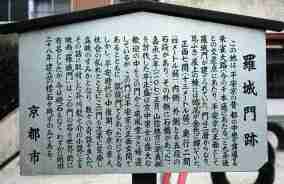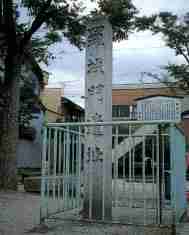[Contents] [Back] [Next] [Section II: The Origins of Kagura]
Rashô-mon Gate
[Kyôto]  Rashô-mon was built as the front gate of Heian-kyô at the intersection of the Suzaku Great Road and Ninth Avenue. It was a tile-roofed, two-storied gate with gold ornamental ridge-end tiles. It thirteen meters wide and four meters deep. There were five stone steps inside and outside the gate, and a stone bridge outside the gate. In the first lunar month of 1107, Taira no Masamori, who subjugated Minamoto no Yoshichika in the San'in Region (modern Kyôto, Hyôgo, Tottori and Shimane Prefectures), returned to Heian-kyô through this gate, where he was warmly welcomed by its citizens, so in addition to being Heiankyô's front gate, Rashô-mon was its l'arc de triomphe. However, during the social rebellion in Yu-kyô in the mid-Heian Period, Rashô-mon fell into disrepair and became a criminal den and the subject of many strange stories. Kurosawa Akira's film adaptation of Akutagawa Ryûnosuke's novel Rashômon (1915) made the gate famous world-wide, but today not even a cornerstone of the original gate remains, and little more than a stone monument erected in 1895 marks the site. |
|
NPO Hiroshima kagura Art Laboratory |
